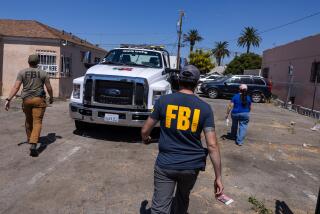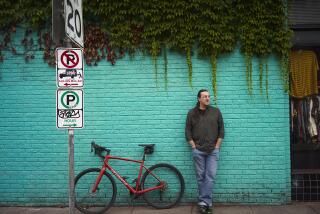Intrigue but no glamour for smuggling case figure
- Share via
White-haired and missing several teeth, a 79-year-old retired steel salesman sat barefoot in a stained undershirt at his modest Cerritos home Wednesday, trying to explain how he had ended up at the center of a major federal smuggling investigation.
It all started when Robert Olson took a trip in the 1970s to Thailand, where he said he picked up an ancient bronze ring and was required to buy it after it broke in his hand.
After learning that collectors and curators back home in Los Angeles were interested in such objects, he made acquiring them his life’s work, buying ancient pottery, huge marble sculptures and lacquered Buddhas from Thai middlemen (including, he says, an uncle of the Thai king). He sold them to people who sold them to museums, movie stars and dignitaries.
“I once had a Buddha that weighed 5,000 pounds,” Olson boasted. “I got stuff no one else got.”
Olson says he never made a lot of money in the trade but enjoyed “turning things around” for a small profit that allowed him to get by. His small apartment, strewn with children’s toys, books and unopened mail, does not speak of wealth.
Olson admits that he knew most of the items he was buying had been illegally excavated and that taking them out of Thailand would violate that country’s laws. But he emphatically denied being a smuggler.
He said he played no direct role in the shipments and claimed that U.S. customs officials told him repeatedly they were not illegal under American law.
On Jan. 24, however, more than a dozen federal agents appeared at Olson’s door at 7:30 a.m. They handed him a detailed search warrant that outlined a five-year undercover operation by “Tom Hoyt,” a man Olson believed to be a computer executive and trusted client. Although he has not been charged with a crime, Olson is referred to throughout the warrants as “the smuggler.”
The warrants suggest that Olson broke the law by importing goods he knew to be stolen and making false declarations on U.S. customs forms.
That same morning, more than 500 federal agents served similar warrants on 13 locations, including the Los Angeles County Museum of Art, Pasadena’s Pacific Asia Museum, the Bowers Museum of Cultural Art in Santa Ana, the Mingei International Museum in San Diego and a private collector’s museum in Chicago.
All five of the museums are alleged to have accepted gifts of looted artifacts from donors who in some cases claimed inflated tax write-offs. Many of these objects, according to the warrants, can be traced to Olson.
Sitting alone in his dark living room Wednesday, Olson wondered what would happen next. He said he would fight to retain custody of his 11-year-old daughter, who was taken by authorities from her school Thursday after federal agents found pictures of naked Thai teenagers among Olson’s belongings.
Olson, divorced from the girl’s Thai mother, said he doesn’t know where the girl is.
“They took my daughter away from me,” he said, stifling tears amid flashes of anger. “They figured I was molesting her, the bastards.”
It appears only a matter of time, Olson said, until he is indicted. With his business shut down, he said, he had to take $10,000 from his daughter’s college fund to pay for his legal defense. “I’m broke,” he said.
Authorities seized Olson’s bank records but would not comment on his finances or any other aspect of his case.
Olson traced his troubles to the mid-’70s, after he quit his job as a salesman in the Los Angeles steel business, where he’d worked for 23 1/2 years “without missing a day.” On a visit to New Mexico, he said, he stumbled upon a new trade -- selling bulk turquoise to Indian jewelry makers across the Southwest. Along the way, Olson began collecting Indian ladles, one of which he had found in a cave.
“That went well until a [guy] in Guadalajara started making fake turquoise and silver and ruined the market,” he said.
Once again out of work, Olson said, he was invited to Thailand for a friend’s wedding.
By then middle-aged and divorced, he liked the attention he received there from young women. “There were girls all over us,” Olson recalled. “You wouldn’t believe it.”
While browsing in an antique shop, he said, he was shown a bronze ring that broke in his hand. He bought it, along with a few pieces of pottery that he was told were from Ban Chiang, an ancient civilization in northern Thailand.
Back in Los Angeles, Olson decided to sell his collection of 73 Indian ladles, the largest anywhere, he said. The then-curator at the Bowers Museum, Armand Labbe, said he’d be right over, Olson recalled.
Labbe was impressed, Olson said. If Olson donated half the ladles to the Bowers, Labbe said he would find someone to pay him $10,000 for the rest.
Labbe also admired Olson’s Thai pottery, Olson said.
“Labbe said, ‘If you can get more of this stuff, they’ll put on a show at the Bowers with it,’ ” Olson recalled.
A partnership was born.
Olson began traveling back and forth between Thailand and Los Angeles, buying Ban Chiang pottery in bulk -- “hundreds and hundreds of pieces” -- from middlemen, Olson said.
The Bowers exhibited the collection for 8 1/2 months, Olson said. He said he paid $24,000 to print a catalog for the exhibit, in which he made sure there was no mention of his name.
Given Thailand’s claim to ownership of the objects, “I wouldn’t be able to get in or out of Thailand if my name was on that book,” he said.
With the attention from the Bowers exhibitions, the value of the Thai artifacts exploded. Olson said he was able to sell them all, many to Barry MacLean, a Chicago collector whose private museum was searched last Thursday.
Importing Thai antiquities then became Olson’s full-time profession. Olson said he spent his days in the antique markets of Bangkok, where he said Thais openly sold their archeological treasures.
Later in his career, he would go to the northern city of Chiang Mai, where Thai middlemen showed him rooms full of recently excavated pottery and bronze. Along the way, he married a woman from a remote hill tribe, the mother of his daughter.
One of his suppliers, Olson claims, was a Thai prince and uncle of the king who in the 1980s sold objects from his personal collection.
Olson’s main competition, he said, were Japanese collectors, who would pick out a few select objects and offer 200,000 baht (about $10,000 at the time). Olson worked it so he could get every object in the room for the same amount. “Generally, I bought in bulk,” he said.
Olson said that he would provide a down payment for the order and that the middlemen would arrange to ship the objects to him in Los Angeles. A few weeks later, a shipping container from the Port of Los Angeles would arrive at his East Anaheim warehouse.
At the peak of his 30-year importing career, Olson said, he would receive three or four such shipments a year. He and a crew used a forklift to load the artifacts into the 600-square-foot warehouse.
In addition to pottery from Ban Chiang, Olson said he bought Burmese lacquered Buddhas, bronze bowls and jewelry, Cambodian sculpture and massive marble sculptures torn from temples.
For a while he bought Chinese antiquities from a shop in Hong Kong, but stopped after being swindled.
In Los Angeles, Olson found a bevy of prominent dealers, collectors and curators eager to acquire his wares. His clients included high-end art and home decor shops in Beverly Hills and the Melrose Avenue area. Jonathan and Cari Markell, owners of the Silk Road Gallery on La Brea Avenue, were some of his best clients, Olson said. The Markells’ gallery and home were also raided by federal agents last Thursday. Cari Markell said the couple would not comment.
For hundreds of minor objects, Labbe and the Markells would find buyers, then bring in appraisers to inflate their value so they could be given to museums in exchange for tax write-offs, the warrants allege. (Labbe died in 2005.)
Olson said he wasn’t in it for the money. He’d typically pay $6 to $7 in Thailand for a small vase that would sell for $8 or $9 in California, he said
One of his most memorable deals was for an 8-foot long lacquered reclining Buddha. He said he bought it for $6,500 in Thailand and sold it to a dealer in California for $7,500. The dealer sold it to a home decorator for $22,000, who sold it to a client for $32,000, he said.
“I was helping the people over there [in Thailand] make money,” he said. “It was just something to do.”
--
More to Read
Sign up for Essential California
The most important California stories and recommendations in your inbox every morning.
You may occasionally receive promotional content from the Los Angeles Times.










